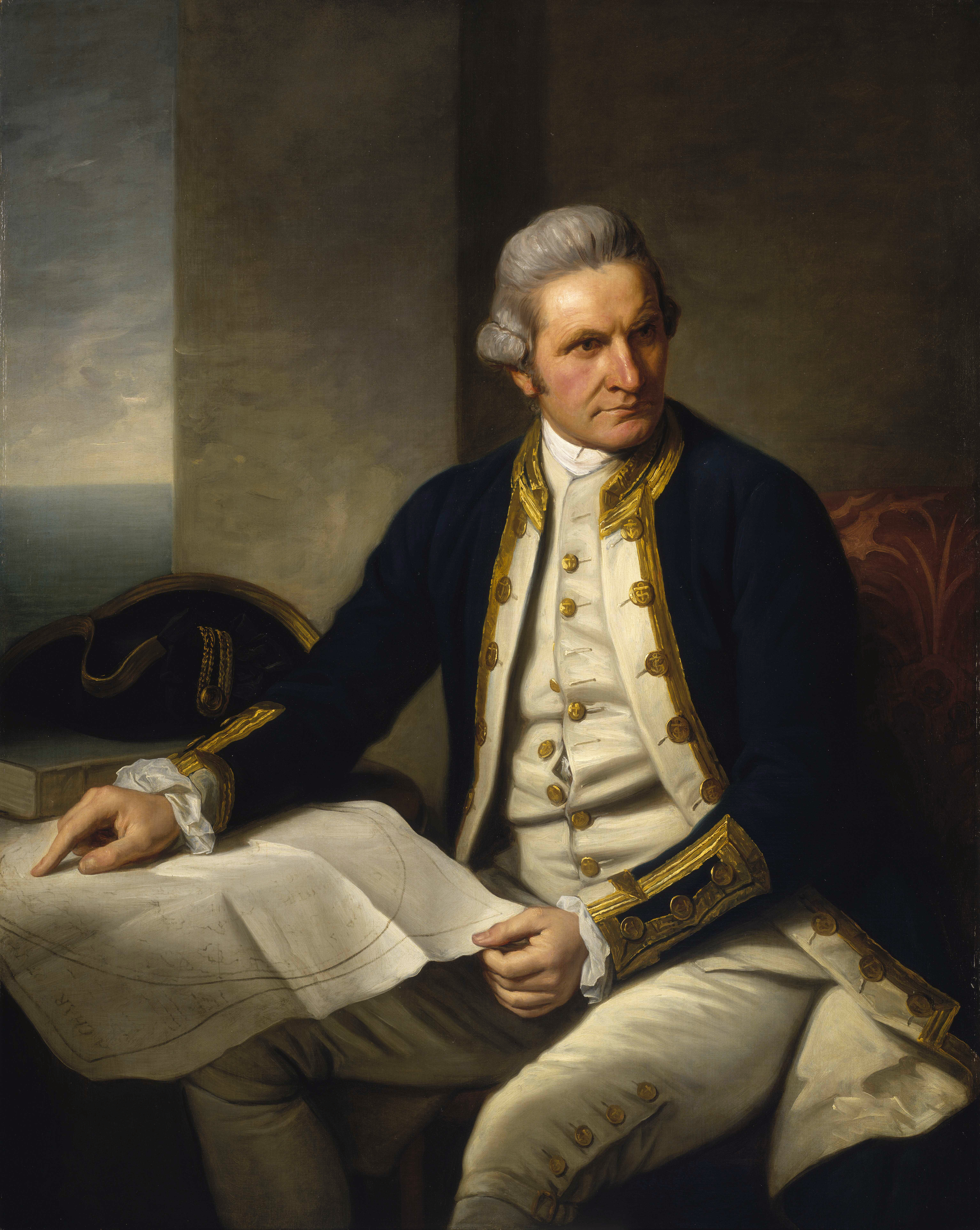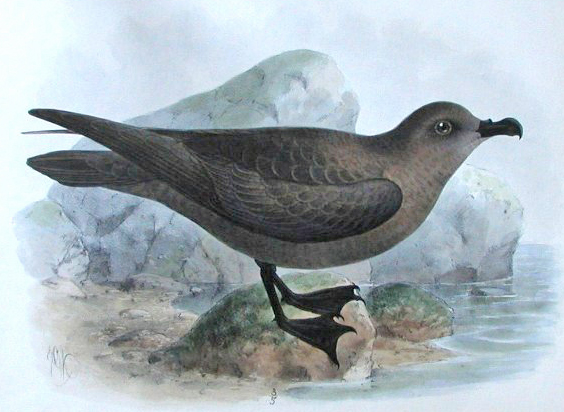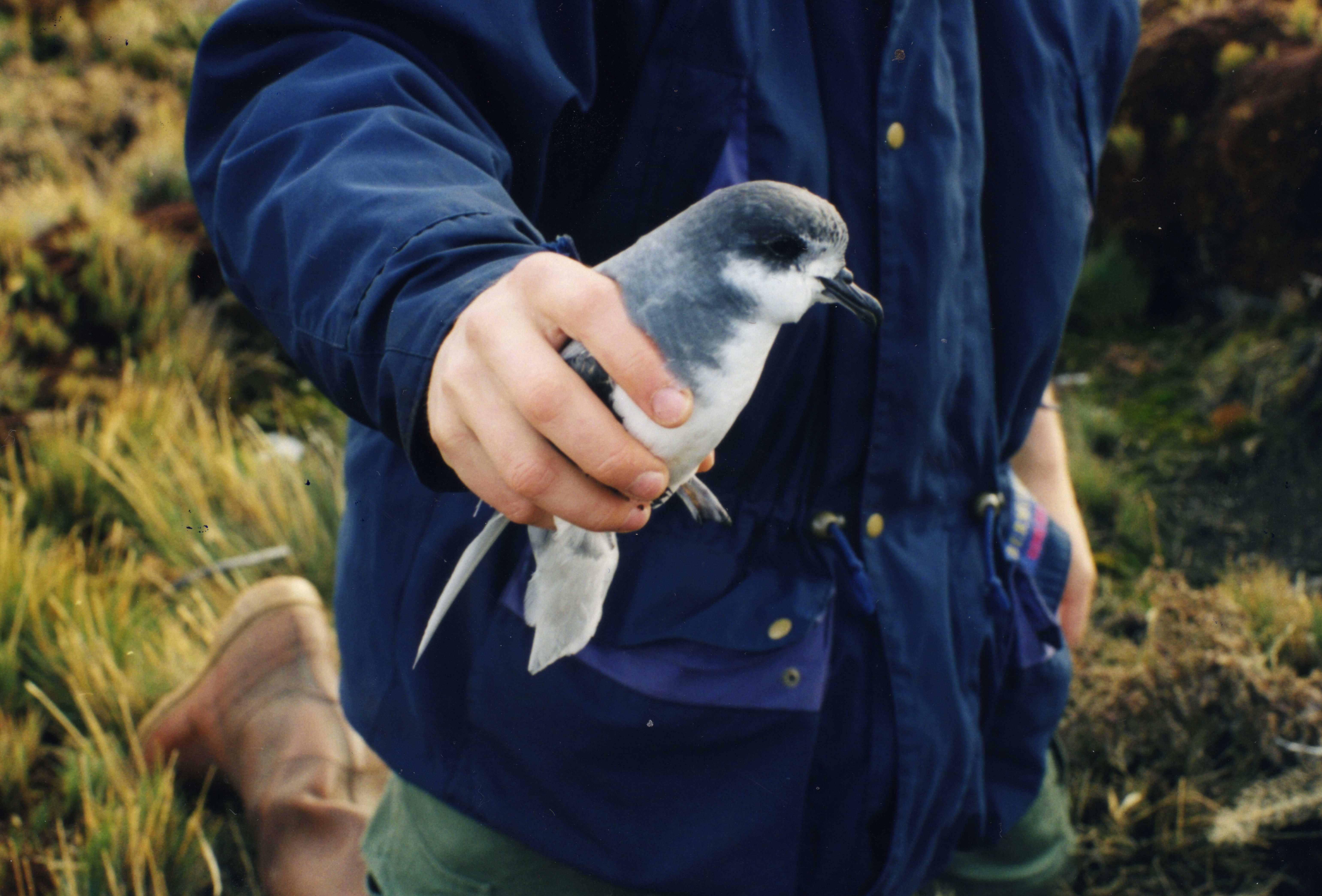|
Broad-billed Prion
The broad-billed prion (''Pachyptila vittata'') is a small pelagic seabird in the shearwater and petrel family, Procellariidae. It is the largest prion, with grey upperparts plumage, and white underparts. The sexes are alike. It ranges from the southeast Atlantic to New Zealand mainly near the Antarctic Convergence. In the south Atlantic it breeds on Tristan da Cunha and Gough Island; in the south Pacific it breeds on islands off the south coast of South Island, New Zealand and on the Chatham Islands. It has many other names that have been used such as blue-billed dove-petrel, broad-billed dove-petrel, long-billed prion, common prion, icebird, and whalebird. Taxonomy The broad-billed prion was described in 1777 by the German naturalist Georg Forster in his book ''A Voyage Round the World''. He had accompanied James Cook on Cook's second voyage to the Pacific. He included a brief description: "the blue petrel, so called from its having a blueish-grey colour, and a band of blackis ... [...More Info...] [...Related Items...] OR: [Wikipedia] [Google] [Baidu] |
Georg Forster
Johann George Adam Forster, also known as Georg Forster (; 27 November 1754 – 10 January 1794), was a German geography, geographer, natural history, naturalist, ethnology, ethnologist, travel literature, travel writer, journalist and revolutionary. At an early age, he accompanied his father, Johann Reinhold Forster, on several scientific expeditions, including James Cook's Second voyage of James Cook, second voyage to the Pacific Ocean, Pacific. His report of that journey, ''A Voyage Round the World'', contributed significantly to the ethnology of the people of Polynesia and remains a respected work. As a result of the report, Forster, who was admitted to the Royal Society at the early age of twenty-two, came to be considered one of the founders of modern scientific travel literature. After returning to continental Europe, Forster turned toward academia. He taught natural history at the Collegium Carolinum (Kassel), Collegium Carolinum in the Ottoneum, Kassel (1778–84), a ... [...More Info...] [...Related Items...] OR: [Wikipedia] [Google] [Baidu] |
Procellaria
Procellaria is a genus of Southern Ocean long-winged seabirds related to prions, and within the order Procellariiformes. The black petrel (''Procellaria parkinsoni'') ranges in the Pacific Ocean, and as far north as Central America. The spectacled petrel (''Procellaria conspicillata'') is confined to the Atlantic Ocean, and the Westland petrel (''Procellaria westlandica'') to the Pacific Ocean. The white-chinned (''Procellaria aequinoctialis'') and grey petrel (''Procellaria cinerea'') range throughout the higher latitudes of the Southern Ocean. Taxonomy The genus ''Procellaria'' was introduced in 1758 by the Swedish naturalist Carl Linnaeus in the tenth edition of his ''Systema Naturae''. The name is from the Latin ''procella'' meaning "storm" or "gale". The type species was designated as the white-chinned petrel by George Robert Gray in 1840. The genus ''Procellaria'' is within the Procellariinae clade, which includes the Shearwaters (a monophyletic group comprising ... [...More Info...] [...Related Items...] OR: [Wikipedia] [Google] [Baidu] |
Stomach Oil
Stomach oil is the light oil composed of neutral dietary lipids found in the proventriculus (fore-gut) of birds in the order Procellariiformes. All albatrosses, procellarids (gadfly petrels and shearwaters) and northern and austral storm petrels use the oil. The only Procellariiformes that do not are the diving petrels. The chemical make up of stomach oil varies from species to species and between individuals, but almost always contains both wax esters and triglycerides. Other compounds found in stomach oil include glycerol ethers, pristane and squalene. Stomach oil has low viscosity and will solidify into a hard wax if allowed to cool. It was once thought that stomach oil was a secretion of the proventriculus, but it is now known to be a residue of the diet created by digestion of the prey items such as krill, squid, copepods and fish. It is thought to serve several functions for Procellariiformes, primarily as an energy store; its calorific value is aroun ... [...More Info...] [...Related Items...] OR: [Wikipedia] [Google] [Baidu] |
Naricorns
A nostril (or naris , : nares ) is either of the two orifices of the nose. They enable the entry and exit of air and other gasses through the nasal cavities. In birds and mammals, they contain branched bones or cartilages called turbinates, whose function is to warm air on inhalation and remove moisture on exhalation. Fish do not breathe through noses, but they do have two small holes used for smelling, which can also be referred to as nostrils (with the exception of Cyclostomi, which have just one nostril). In humans, the nasal cycle is the normal ultradian cycle of each nostril's blood vessels becoming engorged in swelling, then shrinking. The nostrils are separated by the septum. The septum can sometimes be deviated, causing one nostril to appear larger than the other. With extreme damage to the septum and columella, the two nostrils are no longer separated and form a single larger external opening. Like other tetrapods, humans have two external nostrils (anterior nar ... [...More Info...] [...Related Items...] OR: [Wikipedia] [Google] [Baidu] |
Zooplankton
Zooplankton are the heterotrophic component of the planktonic community (the " zoo-" prefix comes from ), having to consume other organisms to thrive. Plankton are aquatic organisms that are unable to swim effectively against currents. Consequently, they drift or are carried along by currents in the ocean, or by currents in seas, lakes or rivers. Zooplankton can be contrasted with phytoplankton (cyanobacteria and microalgae), which are the plant-like component of the plankton community (the " phyto-" prefix comes from , although taxonomically ''not'' plants). Zooplankton are heterotrophic (other-feeding), whereas phytoplankton are autotrophic (self-feeding), often generating biological energy and macromolecules through chlorophyllic carbon fixation using sunlightin other words, zooplankton cannot manufacture their own food, while phytoplankton can. As a result, zooplankton must acquire nutrients by feeding on other organisms such as phytoplankton, which are generally smaller t ... [...More Info...] [...Related Items...] OR: [Wikipedia] [Google] [Baidu] |
Procellariiformes
Procellariiformes is an order (biology), order of seabirds that comprises four family (biology), families: the albatrosses, the Procellariidae, petrels and shearwaters, and two families of storm petrels. Formerly called Tubinares and still called tubenoses in English, procellariiforms are often referred to collectively as the petrels, a term that has been applied to all members of the order,Warham, J. (1996). ''The Behaviour, Population, Biology and Physiology of the Petrels''. London: Academic Press, or more commonly all the families except the albatrosses.Brooke, 2004. They are almost exclusively pelagic (feeding in the open ocean), and have a cosmopolitan distribution across the world's oceans, with the highest species diversity, diversity being around New Zealand. Procellariiforms are seabird colony, colonial, mostly nesting on remote, predator-free islands. The larger species nest on the surface, while most smaller species nest in natural cavities and burrows. They exhibit ... [...More Info...] [...Related Items...] OR: [Wikipedia] [Google] [Baidu] |
Order (biology)
Order () is one of the eight major hierarchical taxonomic ranks in Linnaean taxonomy. It is classified between family and class. In biological classification, the order is a taxonomic rank used in the classification of organisms and recognized by the nomenclature codes. An immediately higher rank, superorder, is sometimes added directly above order, with suborder directly beneath order. An order can also be defined as a group of related families. What does and does not belong to each order is determined by a taxonomist, as is whether a particular order should be recognized at all. Often there is no exact agreement, with different taxonomists each taking a different position. There are no hard rules that a taxonomist needs to follow in describing or recognizing an order. Some taxa are accepted almost universally, while others are recognized only rarely. The name of an order is usually written with a capital letter. For some groups of organisms, their orders may follow consist ... [...More Info...] [...Related Items...] OR: [Wikipedia] [Google] [Baidu] |
Blue Petrel
The blue petrel (''Halobaena caerulea'') is a small seabird in the shearwater and petrel family (biology), family, Procellariidae. This small petrel is the only member of the genus ''Halobaena'', but is closely allied to the prion (bird), prions. It is distributed across the Southern Ocean but breeds at a few island sites, all close to the Antarctic Convergence zone. Taxonomy The blue petrel was first described in 1777 by the German naturalist Georg Forster in his book ''A Voyage Round the World''. He had accompanied James Cook on Cook's Second voyage of James Cook, second voyage to the Pacific. Forster did not give the blue petrel a binomial name, but when the German naturalist Johann Friedrich Gmelin updated Carl Linnaeus's ''Systema Naturae'' in 1789 he included a brief description of the bird, coined the binomial name ''Procellaria caerulea'' and cited Forster's book. The blue petrel is now the only species placed in the genus ''Halobaena'' that was introduced for the blue pet ... [...More Info...] [...Related Items...] OR: [Wikipedia] [Google] [Baidu] |
Beak
The beak, bill, or rostrum is an external anatomical structure found mostly in birds, but also in turtles, non-avian dinosaurs and a few mammals. A beak is used for pecking, grasping, and holding (in probing for food, eating, manipulating and carrying objects, killing prey, or fighting), preening, courtship, and feeding young. The terms ''beak'' and '' rostrum'' are also used to refer to a similar mouth part in some ornithischians, pterosaurs, cetaceans, dicynodonts, rhynchosaurs, anuran tadpoles, monotremes (i.e. echidnas and platypuses, which have a bill-like structure), sirens, pufferfish, billfishes, and cephalopods. Although beaks vary significantly in size, shape, color and texture, they share a similar underlying structure. Two bony projections–the upper and lower mandibles–are covered with a thin keratinized layer of epidermis known as the rhamphotheca. In most species, two holes called ''nares'' lead to the respiratory system. Etymology Although the wo ... [...More Info...] [...Related Items...] OR: [Wikipedia] [Google] [Baidu] |
Latin
Latin ( or ) is a classical language belonging to the Italic languages, Italic branch of the Indo-European languages. Latin was originally spoken by the Latins (Italic tribe), Latins in Latium (now known as Lazio), the lower Tiber area around Rome, Italy. Through the expansion of the Roman Republic, it became the dominant language in the Italian Peninsula and subsequently throughout the Roman Empire. It has greatly influenced many languages, Latin influence in English, including English, having contributed List of Latin words with English derivatives, many words to the English lexicon, particularly after the Christianity in Anglo-Saxon England, Christianization of the Anglo-Saxons and the Norman Conquest. Latin Root (linguistics), roots appear frequently in the technical vocabulary used by fields such as theology, List of Latin and Greek words commonly used in systematic names, the sciences, List of medical roots, suffixes and prefixes, medicine, and List of Latin legal terms ... [...More Info...] [...Related Items...] OR: [Wikipedia] [Google] [Baidu] |
Ancient Greek
Ancient Greek (, ; ) includes the forms of the Greek language used in ancient Greece and the classical antiquity, ancient world from around 1500 BC to 300 BC. It is often roughly divided into the following periods: Mycenaean Greek (), Greek Dark Ages, Dark Ages (), the Archaic Greece, Archaic or Homeric Greek, Homeric period (), and the Classical Greece, Classical period (). Ancient Greek was the language of Homer and of fifth-century Athens, fifth-century Athenian historians, playwrights, and Ancient Greek philosophy, philosophers. It has contributed many words to English vocabulary and has been a standard subject of study in educational institutions of the Western world since the Renaissance. This article primarily contains information about the Homeric Greek, Epic and Classical periods of the language, which are the best-attested periods and considered most typical of Ancient Greek. From the Hellenistic period (), Ancient Greek was followed by Koine Greek, which is regar ... [...More Info...] [...Related Items...] OR: [Wikipedia] [Google] [Baidu] |
Johann Karl Wilhelm Illiger
Johann Karl Wilhelm Illiger (19 November 1775 – 10 May 1813) was a German entomologist and zoologist. He founded the entomological periodical ''Magazin für Insektenkunde.'' The plant genus '' Illigera'' is named in his honour. Biography Illiger was the son of a merchant in Braunschweig. He studied under the entomologist Johann Hellwig, and later worked on the zoological collections of Johann Centurius Hoffmannsegg. He was educated at the University of Helmstedt and at Gottingen. He was unable to pursue medical studies due to tuberculosis. Illiger was invited to Berlin by Alexander von Humboldt and he became professor and director of the "zoological museum" (which is the Natural History Museum of Berlin in the present day) from its formation in 1810 until his death three years later from tuberculosis. He was the author of ''Prodromus systematis mammalium et avium'' (1811), which was an overhaul of the Linnaean system. It was a major influence on the adoption of the concept ... [...More Info...] [...Related Items...] OR: [Wikipedia] [Google] [Baidu] |






